Nursing and medical Diagnosis Assignment
VerifiedAdded on 2021/05/30
|7
|2041
|76
AI Summary
Contribute Materials
Your contribution can guide someone’s learning journey. Share your
documents today.
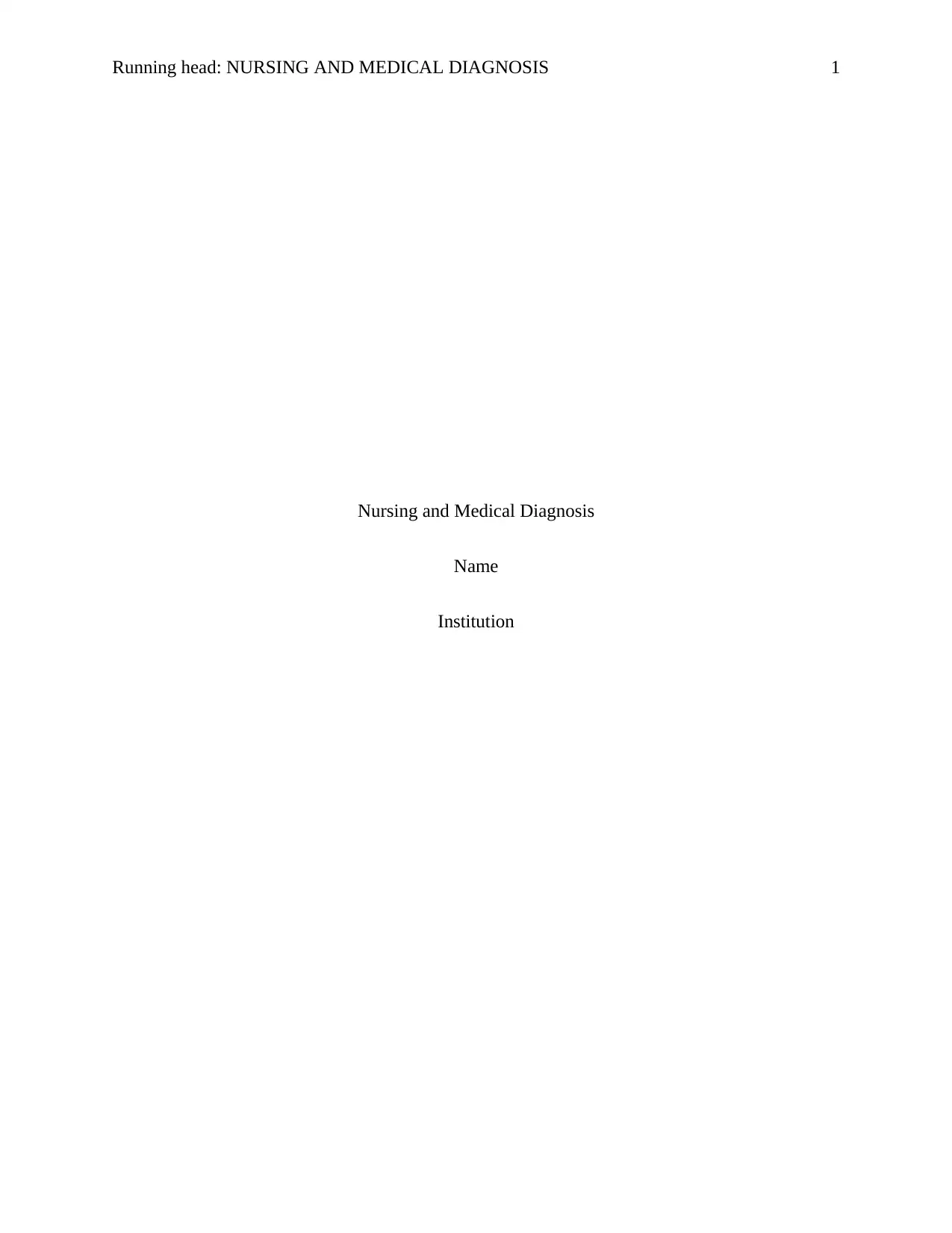
Running head: NURSING AND MEDICAL DIAGNOSIS 1
Nursing and Medical Diagnosis
Name
Institution
Nursing and Medical Diagnosis
Name
Institution
Secure Best Marks with AI Grader
Need help grading? Try our AI Grader for instant feedback on your assignments.
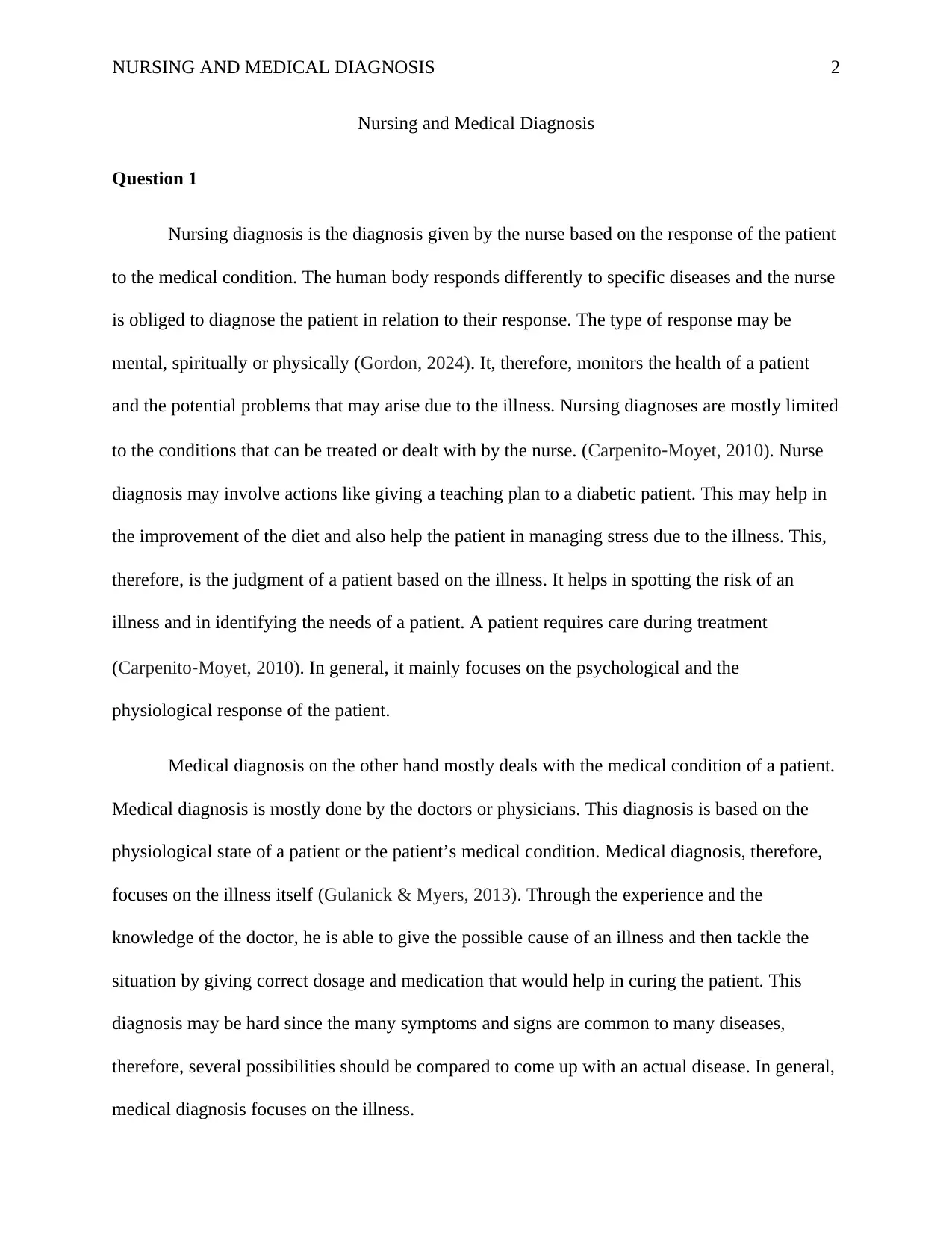
NURSING AND MEDICAL DIAGNOSIS 2
Nursing and Medical Diagnosis
Question 1
Nursing diagnosis is the diagnosis given by the nurse based on the response of the patient
to the medical condition. The human body responds differently to specific diseases and the nurse
is obliged to diagnose the patient in relation to their response. The type of response may be
mental, spiritually or physically (Gordon, 2024). It, therefore, monitors the health of a patient
and the potential problems that may arise due to the illness. Nursing diagnoses are mostly limited
to the conditions that can be treated or dealt with by the nurse. (Carpenito‐Moyet, 2010). Nurse
diagnosis may involve actions like giving a teaching plan to a diabetic patient. This may help in
the improvement of the diet and also help the patient in managing stress due to the illness. This,
therefore, is the judgment of a patient based on the illness. It helps in spotting the risk of an
illness and in identifying the needs of a patient. A patient requires care during treatment
(Carpenito‐Moyet, 2010). In general, it mainly focuses on the psychological and the
physiological response of the patient.
Medical diagnosis on the other hand mostly deals with the medical condition of a patient.
Medical diagnosis is mostly done by the doctors or physicians. This diagnosis is based on the
physiological state of a patient or the patient’s medical condition. Medical diagnosis, therefore,
focuses on the illness itself (Gulanick & Myers, 2013). Through the experience and the
knowledge of the doctor, he is able to give the possible cause of an illness and then tackle the
situation by giving correct dosage and medication that would help in curing the patient. This
diagnosis may be hard since the many symptoms and signs are common to many diseases,
therefore, several possibilities should be compared to come up with an actual disease. In general,
medical diagnosis focuses on the illness.
Nursing and Medical Diagnosis
Question 1
Nursing diagnosis is the diagnosis given by the nurse based on the response of the patient
to the medical condition. The human body responds differently to specific diseases and the nurse
is obliged to diagnose the patient in relation to their response. The type of response may be
mental, spiritually or physically (Gordon, 2024). It, therefore, monitors the health of a patient
and the potential problems that may arise due to the illness. Nursing diagnoses are mostly limited
to the conditions that can be treated or dealt with by the nurse. (Carpenito‐Moyet, 2010). Nurse
diagnosis may involve actions like giving a teaching plan to a diabetic patient. This may help in
the improvement of the diet and also help the patient in managing stress due to the illness. This,
therefore, is the judgment of a patient based on the illness. It helps in spotting the risk of an
illness and in identifying the needs of a patient. A patient requires care during treatment
(Carpenito‐Moyet, 2010). In general, it mainly focuses on the psychological and the
physiological response of the patient.
Medical diagnosis on the other hand mostly deals with the medical condition of a patient.
Medical diagnosis is mostly done by the doctors or physicians. This diagnosis is based on the
physiological state of a patient or the patient’s medical condition. Medical diagnosis, therefore,
focuses on the illness itself (Gulanick & Myers, 2013). Through the experience and the
knowledge of the doctor, he is able to give the possible cause of an illness and then tackle the
situation by giving correct dosage and medication that would help in curing the patient. This
diagnosis may be hard since the many symptoms and signs are common to many diseases,
therefore, several possibilities should be compared to come up with an actual disease. In general,
medical diagnosis focuses on the illness.
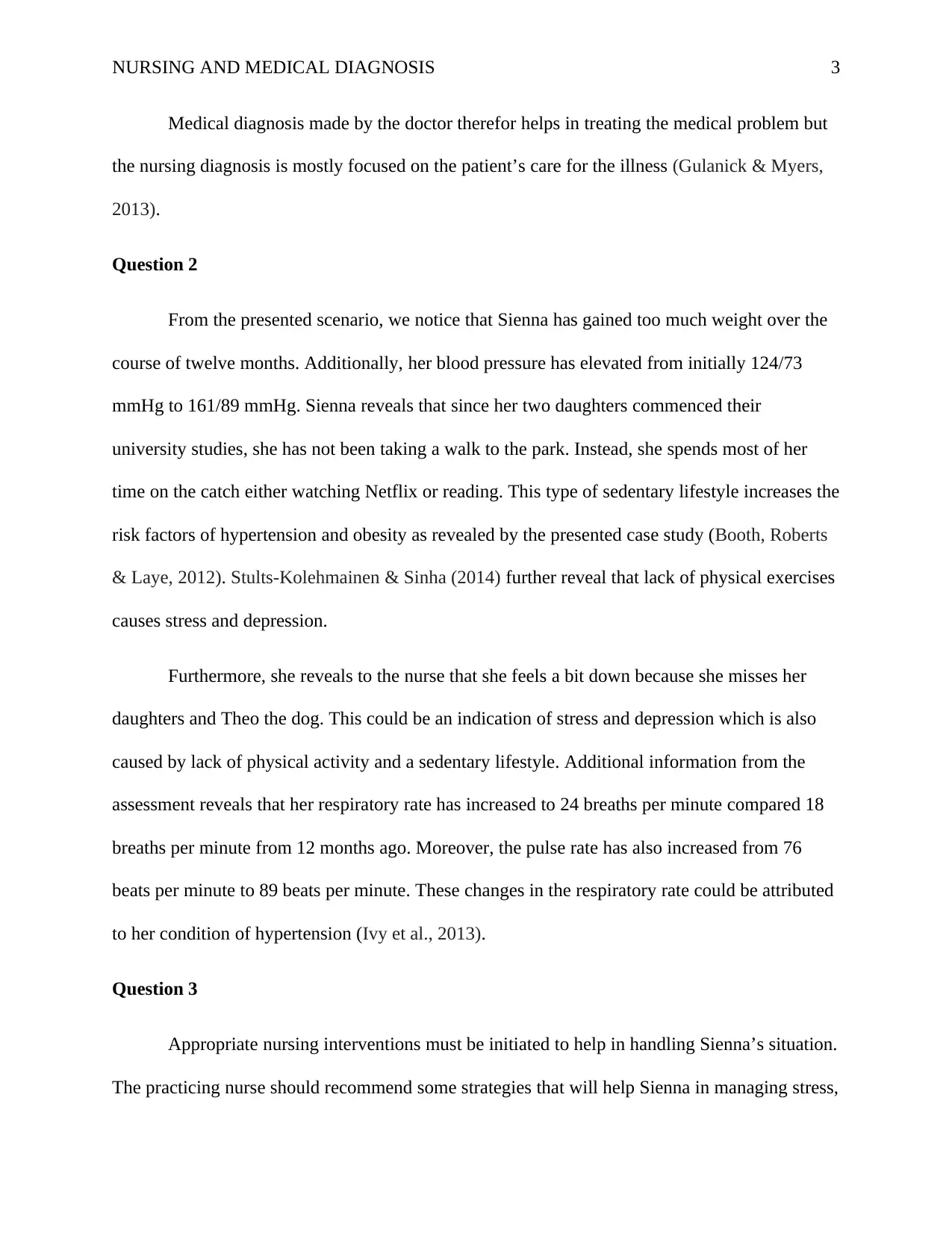
NURSING AND MEDICAL DIAGNOSIS 3
Medical diagnosis made by the doctor therefor helps in treating the medical problem but
the nursing diagnosis is mostly focused on the patient’s care for the illness (Gulanick & Myers,
2013).
Question 2
From the presented scenario, we notice that Sienna has gained too much weight over the
course of twelve months. Additionally, her blood pressure has elevated from initially 124/73
mmHg to 161/89 mmHg. Sienna reveals that since her two daughters commenced their
university studies, she has not been taking a walk to the park. Instead, she spends most of her
time on the catch either watching Netflix or reading. This type of sedentary lifestyle increases the
risk factors of hypertension and obesity as revealed by the presented case study (Booth, Roberts
& Laye, 2012). Stults-Kolehmainen & Sinha (2014) further reveal that lack of physical exercises
causes stress and depression.
Furthermore, she reveals to the nurse that she feels a bit down because she misses her
daughters and Theo the dog. This could be an indication of stress and depression which is also
caused by lack of physical activity and a sedentary lifestyle. Additional information from the
assessment reveals that her respiratory rate has increased to 24 breaths per minute compared 18
breaths per minute from 12 months ago. Moreover, the pulse rate has also increased from 76
beats per minute to 89 beats per minute. These changes in the respiratory rate could be attributed
to her condition of hypertension (Ivy et al., 2013).
Question 3
Appropriate nursing interventions must be initiated to help in handling Sienna’s situation.
The practicing nurse should recommend some strategies that will help Sienna in managing stress,
Medical diagnosis made by the doctor therefor helps in treating the medical problem but
the nursing diagnosis is mostly focused on the patient’s care for the illness (Gulanick & Myers,
2013).
Question 2
From the presented scenario, we notice that Sienna has gained too much weight over the
course of twelve months. Additionally, her blood pressure has elevated from initially 124/73
mmHg to 161/89 mmHg. Sienna reveals that since her two daughters commenced their
university studies, she has not been taking a walk to the park. Instead, she spends most of her
time on the catch either watching Netflix or reading. This type of sedentary lifestyle increases the
risk factors of hypertension and obesity as revealed by the presented case study (Booth, Roberts
& Laye, 2012). Stults-Kolehmainen & Sinha (2014) further reveal that lack of physical exercises
causes stress and depression.
Furthermore, she reveals to the nurse that she feels a bit down because she misses her
daughters and Theo the dog. This could be an indication of stress and depression which is also
caused by lack of physical activity and a sedentary lifestyle. Additional information from the
assessment reveals that her respiratory rate has increased to 24 breaths per minute compared 18
breaths per minute from 12 months ago. Moreover, the pulse rate has also increased from 76
beats per minute to 89 beats per minute. These changes in the respiratory rate could be attributed
to her condition of hypertension (Ivy et al., 2013).
Question 3
Appropriate nursing interventions must be initiated to help in handling Sienna’s situation.
The practicing nurse should recommend some strategies that will help Sienna in managing stress,
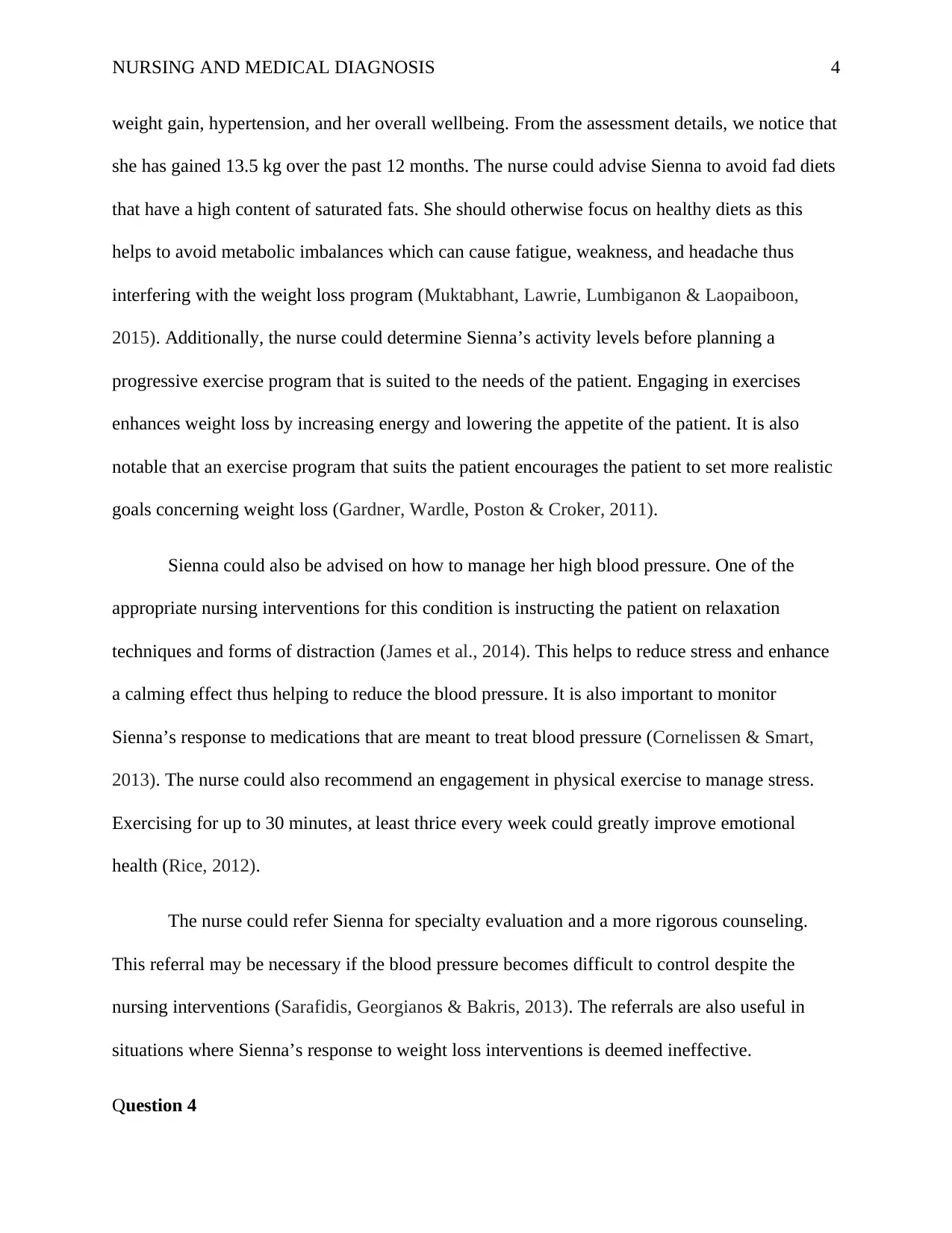
NURSING AND MEDICAL DIAGNOSIS 4
weight gain, hypertension, and her overall wellbeing. From the assessment details, we notice that
she has gained 13.5 kg over the past 12 months. The nurse could advise Sienna to avoid fad diets
that have a high content of saturated fats. She should otherwise focus on healthy diets as this
helps to avoid metabolic imbalances which can cause fatigue, weakness, and headache thus
interfering with the weight loss program (Muktabhant, Lawrie, Lumbiganon & Laopaiboon,
2015). Additionally, the nurse could determine Sienna’s activity levels before planning a
progressive exercise program that is suited to the needs of the patient. Engaging in exercises
enhances weight loss by increasing energy and lowering the appetite of the patient. It is also
notable that an exercise program that suits the patient encourages the patient to set more realistic
goals concerning weight loss (Gardner, Wardle, Poston & Croker, 2011).
Sienna could also be advised on how to manage her high blood pressure. One of the
appropriate nursing interventions for this condition is instructing the patient on relaxation
techniques and forms of distraction (James et al., 2014). This helps to reduce stress and enhance
a calming effect thus helping to reduce the blood pressure. It is also important to monitor
Sienna’s response to medications that are meant to treat blood pressure (Cornelissen & Smart,
2013). The nurse could also recommend an engagement in physical exercise to manage stress.
Exercising for up to 30 minutes, at least thrice every week could greatly improve emotional
health (Rice, 2012).
The nurse could refer Sienna for specialty evaluation and a more rigorous counseling.
This referral may be necessary if the blood pressure becomes difficult to control despite the
nursing interventions (Sarafidis, Georgianos & Bakris, 2013). The referrals are also useful in
situations where Sienna’s response to weight loss interventions is deemed ineffective.
Question 4
weight gain, hypertension, and her overall wellbeing. From the assessment details, we notice that
she has gained 13.5 kg over the past 12 months. The nurse could advise Sienna to avoid fad diets
that have a high content of saturated fats. She should otherwise focus on healthy diets as this
helps to avoid metabolic imbalances which can cause fatigue, weakness, and headache thus
interfering with the weight loss program (Muktabhant, Lawrie, Lumbiganon & Laopaiboon,
2015). Additionally, the nurse could determine Sienna’s activity levels before planning a
progressive exercise program that is suited to the needs of the patient. Engaging in exercises
enhances weight loss by increasing energy and lowering the appetite of the patient. It is also
notable that an exercise program that suits the patient encourages the patient to set more realistic
goals concerning weight loss (Gardner, Wardle, Poston & Croker, 2011).
Sienna could also be advised on how to manage her high blood pressure. One of the
appropriate nursing interventions for this condition is instructing the patient on relaxation
techniques and forms of distraction (James et al., 2014). This helps to reduce stress and enhance
a calming effect thus helping to reduce the blood pressure. It is also important to monitor
Sienna’s response to medications that are meant to treat blood pressure (Cornelissen & Smart,
2013). The nurse could also recommend an engagement in physical exercise to manage stress.
Exercising for up to 30 minutes, at least thrice every week could greatly improve emotional
health (Rice, 2012).
The nurse could refer Sienna for specialty evaluation and a more rigorous counseling.
This referral may be necessary if the blood pressure becomes difficult to control despite the
nursing interventions (Sarafidis, Georgianos & Bakris, 2013). The referrals are also useful in
situations where Sienna’s response to weight loss interventions is deemed ineffective.
Question 4
Secure Best Marks with AI Grader
Need help grading? Try our AI Grader for instant feedback on your assignments.
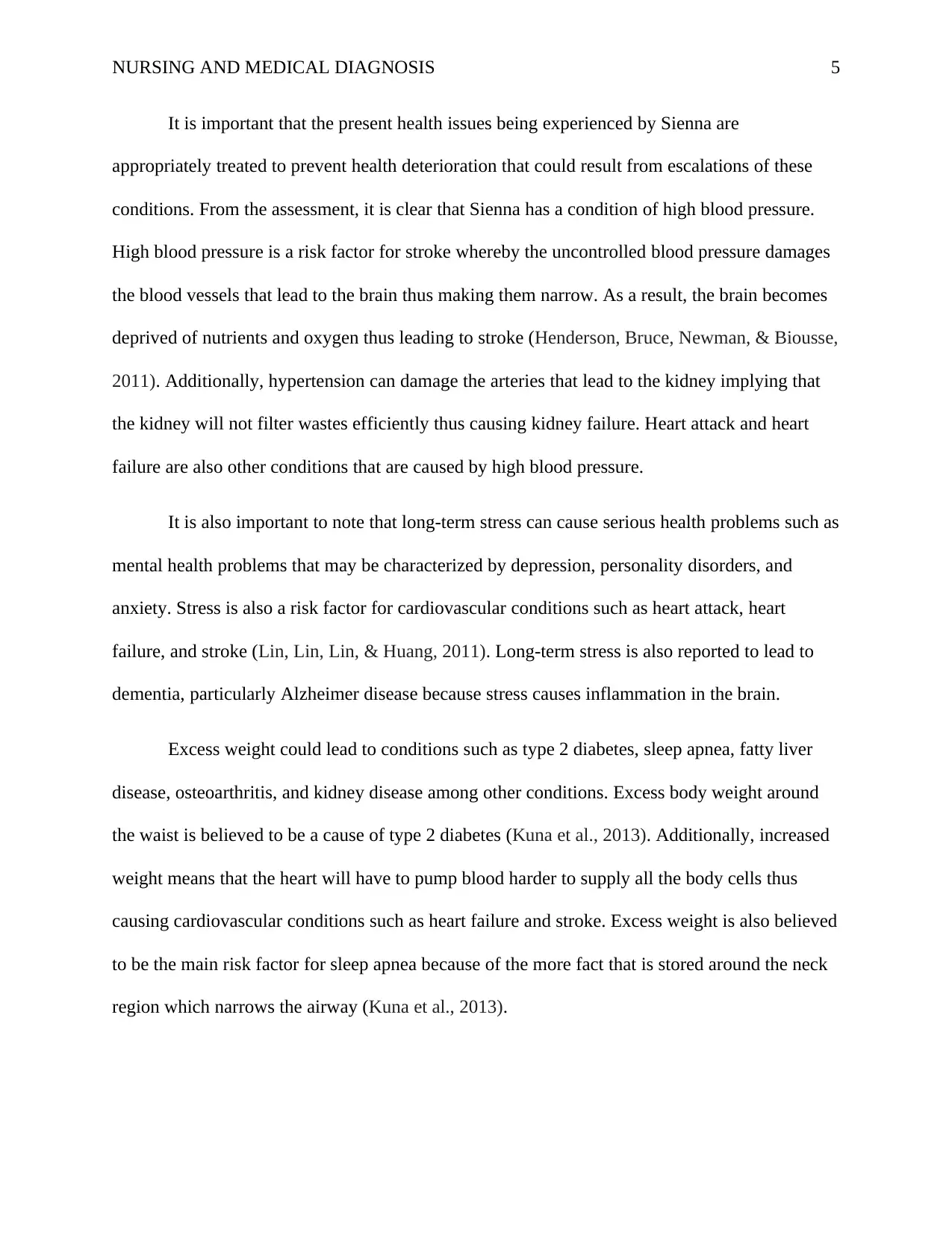
NURSING AND MEDICAL DIAGNOSIS 5
It is important that the present health issues being experienced by Sienna are
appropriately treated to prevent health deterioration that could result from escalations of these
conditions. From the assessment, it is clear that Sienna has a condition of high blood pressure.
High blood pressure is a risk factor for stroke whereby the uncontrolled blood pressure damages
the blood vessels that lead to the brain thus making them narrow. As a result, the brain becomes
deprived of nutrients and oxygen thus leading to stroke (Henderson, Bruce, Newman, & Biousse,
2011). Additionally, hypertension can damage the arteries that lead to the kidney implying that
the kidney will not filter wastes efficiently thus causing kidney failure. Heart attack and heart
failure are also other conditions that are caused by high blood pressure.
It is also important to note that long-term stress can cause serious health problems such as
mental health problems that may be characterized by depression, personality disorders, and
anxiety. Stress is also a risk factor for cardiovascular conditions such as heart attack, heart
failure, and stroke (Lin, Lin, Lin, & Huang, 2011). Long-term stress is also reported to lead to
dementia, particularly Alzheimer disease because stress causes inflammation in the brain.
Excess weight could lead to conditions such as type 2 diabetes, sleep apnea, fatty liver
disease, osteoarthritis, and kidney disease among other conditions. Excess body weight around
the waist is believed to be a cause of type 2 diabetes (Kuna et al., 2013). Additionally, increased
weight means that the heart will have to pump blood harder to supply all the body cells thus
causing cardiovascular conditions such as heart failure and stroke. Excess weight is also believed
to be the main risk factor for sleep apnea because of the more fact that is stored around the neck
region which narrows the airway (Kuna et al., 2013).
It is important that the present health issues being experienced by Sienna are
appropriately treated to prevent health deterioration that could result from escalations of these
conditions. From the assessment, it is clear that Sienna has a condition of high blood pressure.
High blood pressure is a risk factor for stroke whereby the uncontrolled blood pressure damages
the blood vessels that lead to the brain thus making them narrow. As a result, the brain becomes
deprived of nutrients and oxygen thus leading to stroke (Henderson, Bruce, Newman, & Biousse,
2011). Additionally, hypertension can damage the arteries that lead to the kidney implying that
the kidney will not filter wastes efficiently thus causing kidney failure. Heart attack and heart
failure are also other conditions that are caused by high blood pressure.
It is also important to note that long-term stress can cause serious health problems such as
mental health problems that may be characterized by depression, personality disorders, and
anxiety. Stress is also a risk factor for cardiovascular conditions such as heart attack, heart
failure, and stroke (Lin, Lin, Lin, & Huang, 2011). Long-term stress is also reported to lead to
dementia, particularly Alzheimer disease because stress causes inflammation in the brain.
Excess weight could lead to conditions such as type 2 diabetes, sleep apnea, fatty liver
disease, osteoarthritis, and kidney disease among other conditions. Excess body weight around
the waist is believed to be a cause of type 2 diabetes (Kuna et al., 2013). Additionally, increased
weight means that the heart will have to pump blood harder to supply all the body cells thus
causing cardiovascular conditions such as heart failure and stroke. Excess weight is also believed
to be the main risk factor for sleep apnea because of the more fact that is stored around the neck
region which narrows the airway (Kuna et al., 2013).
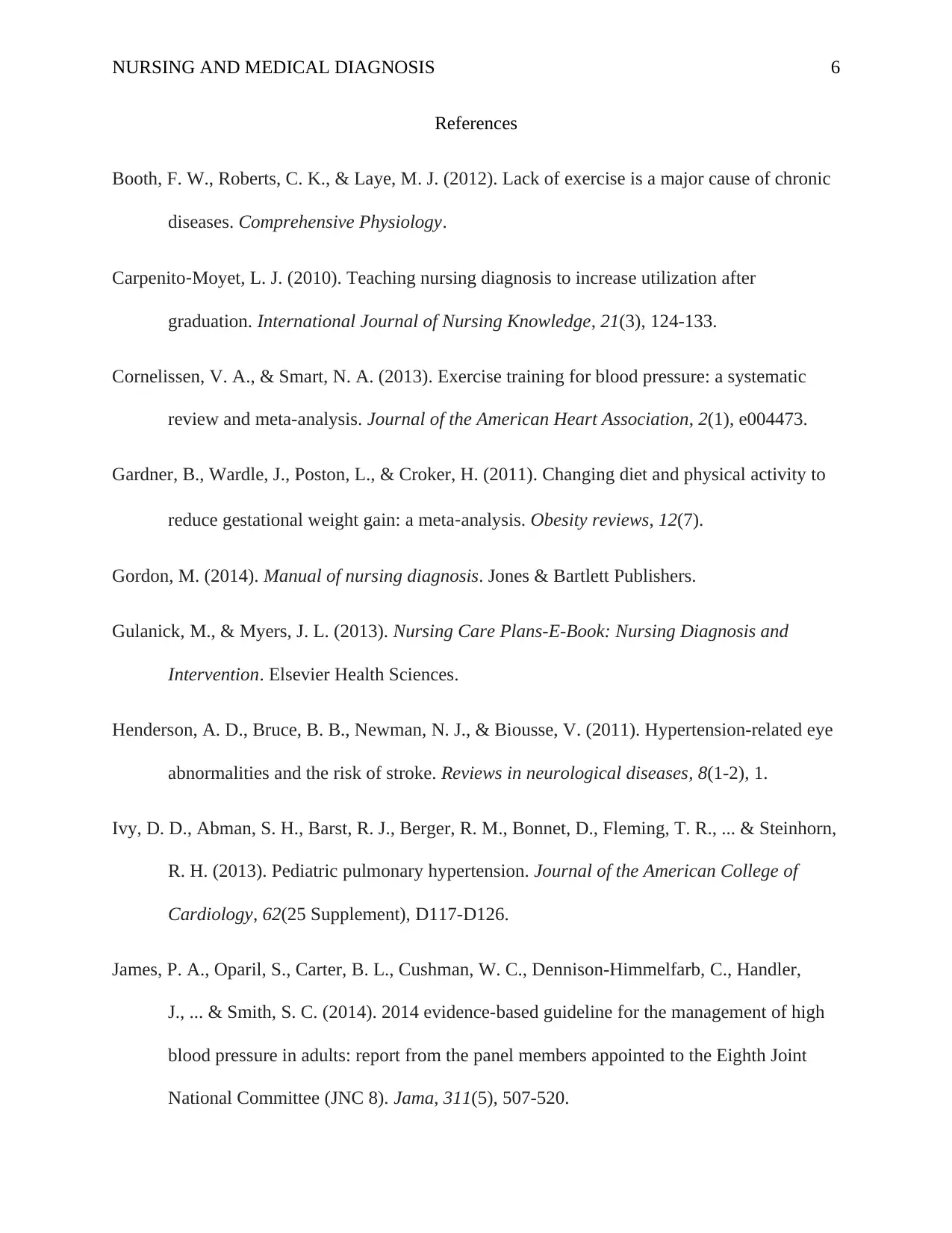
NURSING AND MEDICAL DIAGNOSIS 6
References
Booth, F. W., Roberts, C. K., & Laye, M. J. (2012). Lack of exercise is a major cause of chronic
diseases. Comprehensive Physiology.
Carpenito‐Moyet, L. J. (2010). Teaching nursing diagnosis to increase utilization after
graduation. International Journal of Nursing Knowledge, 21(3), 124-133.
Cornelissen, V. A., & Smart, N. A. (2013). Exercise training for blood pressure: a systematic
review and meta-analysis. Journal of the American Heart Association, 2(1), e004473.
Gardner, B., Wardle, J., Poston, L., & Croker, H. (2011). Changing diet and physical activity to
reduce gestational weight gain: a meta‐analysis. Obesity reviews, 12(7).
Gordon, M. (2014). Manual of nursing diagnosis. Jones & Bartlett Publishers.
Gulanick, M., & Myers, J. L. (2013). Nursing Care Plans-E-Book: Nursing Diagnosis and
Intervention. Elsevier Health Sciences.
Henderson, A. D., Bruce, B. B., Newman, N. J., & Biousse, V. (2011). Hypertension-related eye
abnormalities and the risk of stroke. Reviews in neurological diseases, 8(1-2), 1.
Ivy, D. D., Abman, S. H., Barst, R. J., Berger, R. M., Bonnet, D., Fleming, T. R., ... & Steinhorn,
R. H. (2013). Pediatric pulmonary hypertension. Journal of the American College of
Cardiology, 62(25 Supplement), D117-D126.
James, P. A., Oparil, S., Carter, B. L., Cushman, W. C., Dennison-Himmelfarb, C., Handler,
J., ... & Smith, S. C. (2014). 2014 evidence-based guideline for the management of high
blood pressure in adults: report from the panel members appointed to the Eighth Joint
National Committee (JNC 8). Jama, 311(5), 507-520.
References
Booth, F. W., Roberts, C. K., & Laye, M. J. (2012). Lack of exercise is a major cause of chronic
diseases. Comprehensive Physiology.
Carpenito‐Moyet, L. J. (2010). Teaching nursing diagnosis to increase utilization after
graduation. International Journal of Nursing Knowledge, 21(3), 124-133.
Cornelissen, V. A., & Smart, N. A. (2013). Exercise training for blood pressure: a systematic
review and meta-analysis. Journal of the American Heart Association, 2(1), e004473.
Gardner, B., Wardle, J., Poston, L., & Croker, H. (2011). Changing diet and physical activity to
reduce gestational weight gain: a meta‐analysis. Obesity reviews, 12(7).
Gordon, M. (2014). Manual of nursing diagnosis. Jones & Bartlett Publishers.
Gulanick, M., & Myers, J. L. (2013). Nursing Care Plans-E-Book: Nursing Diagnosis and
Intervention. Elsevier Health Sciences.
Henderson, A. D., Bruce, B. B., Newman, N. J., & Biousse, V. (2011). Hypertension-related eye
abnormalities and the risk of stroke. Reviews in neurological diseases, 8(1-2), 1.
Ivy, D. D., Abman, S. H., Barst, R. J., Berger, R. M., Bonnet, D., Fleming, T. R., ... & Steinhorn,
R. H. (2013). Pediatric pulmonary hypertension. Journal of the American College of
Cardiology, 62(25 Supplement), D117-D126.
James, P. A., Oparil, S., Carter, B. L., Cushman, W. C., Dennison-Himmelfarb, C., Handler,
J., ... & Smith, S. C. (2014). 2014 evidence-based guideline for the management of high
blood pressure in adults: report from the panel members appointed to the Eighth Joint
National Committee (JNC 8). Jama, 311(5), 507-520.
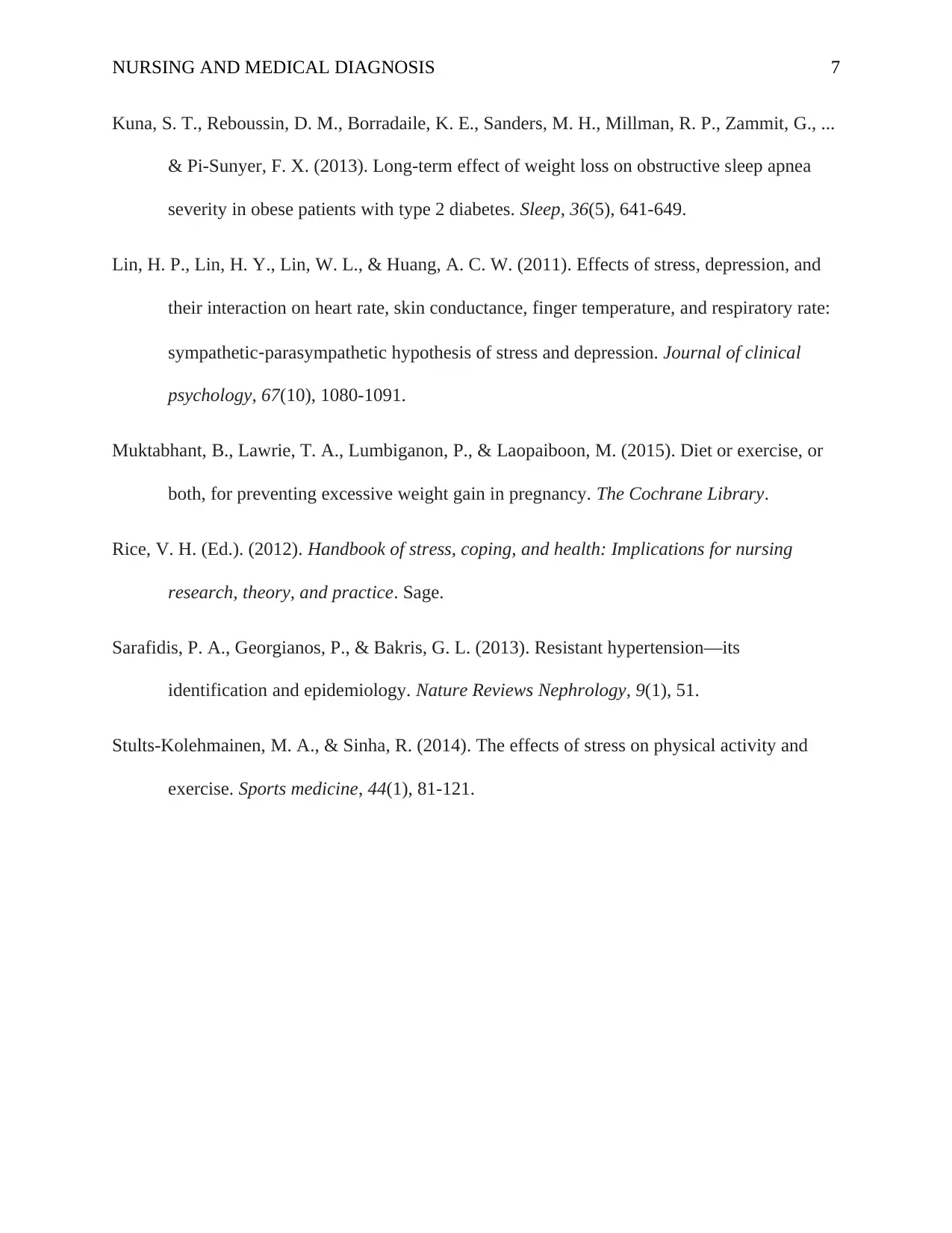
NURSING AND MEDICAL DIAGNOSIS 7
Kuna, S. T., Reboussin, D. M., Borradaile, K. E., Sanders, M. H., Millman, R. P., Zammit, G., ...
& Pi-Sunyer, F. X. (2013). Long-term effect of weight loss on obstructive sleep apnea
severity in obese patients with type 2 diabetes. Sleep, 36(5), 641-649.
Lin, H. P., Lin, H. Y., Lin, W. L., & Huang, A. C. W. (2011). Effects of stress, depression, and
their interaction on heart rate, skin conductance, finger temperature, and respiratory rate:
sympathetic‐parasympathetic hypothesis of stress and depression. Journal of clinical
psychology, 67(10), 1080-1091.
Muktabhant, B., Lawrie, T. A., Lumbiganon, P., & Laopaiboon, M. (2015). Diet or exercise, or
both, for preventing excessive weight gain in pregnancy. The Cochrane Library.
Rice, V. H. (Ed.). (2012). Handbook of stress, coping, and health: Implications for nursing
research, theory, and practice. Sage.
Sarafidis, P. A., Georgianos, P., & Bakris, G. L. (2013). Resistant hypertension—its
identification and epidemiology. Nature Reviews Nephrology, 9(1), 51.
Stults-Kolehmainen, M. A., & Sinha, R. (2014). The effects of stress on physical activity and
exercise. Sports medicine, 44(1), 81-121.
Kuna, S. T., Reboussin, D. M., Borradaile, K. E., Sanders, M. H., Millman, R. P., Zammit, G., ...
& Pi-Sunyer, F. X. (2013). Long-term effect of weight loss on obstructive sleep apnea
severity in obese patients with type 2 diabetes. Sleep, 36(5), 641-649.
Lin, H. P., Lin, H. Y., Lin, W. L., & Huang, A. C. W. (2011). Effects of stress, depression, and
their interaction on heart rate, skin conductance, finger temperature, and respiratory rate:
sympathetic‐parasympathetic hypothesis of stress and depression. Journal of clinical
psychology, 67(10), 1080-1091.
Muktabhant, B., Lawrie, T. A., Lumbiganon, P., & Laopaiboon, M. (2015). Diet or exercise, or
both, for preventing excessive weight gain in pregnancy. The Cochrane Library.
Rice, V. H. (Ed.). (2012). Handbook of stress, coping, and health: Implications for nursing
research, theory, and practice. Sage.
Sarafidis, P. A., Georgianos, P., & Bakris, G. L. (2013). Resistant hypertension—its
identification and epidemiology. Nature Reviews Nephrology, 9(1), 51.
Stults-Kolehmainen, M. A., & Sinha, R. (2014). The effects of stress on physical activity and
exercise. Sports medicine, 44(1), 81-121.
1 out of 7
Related Documents
Your All-in-One AI-Powered Toolkit for Academic Success.
+13062052269
info@desklib.com
Available 24*7 on WhatsApp / Email
![[object Object]](/_next/static/media/star-bottom.7253800d.svg)
Unlock your academic potential
© 2024 | Zucol Services PVT LTD | All rights reserved.





